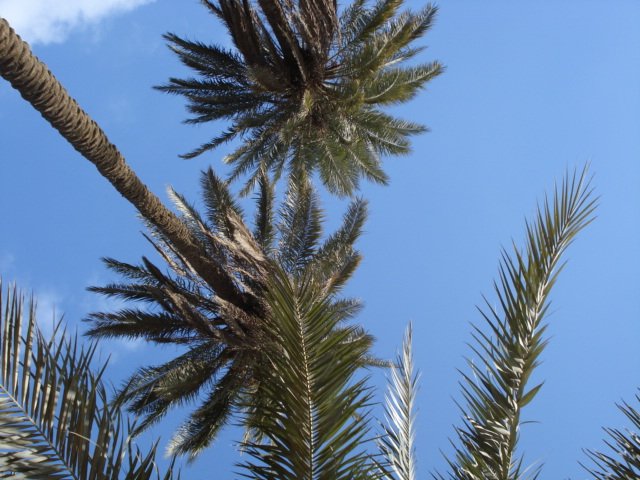
In oak trees the wind rustles. It whispers in the pines and it murmurs in the cottonwoods and aspens. It murmurs in tulip poplars too, but more emphatically. After all, those are big trees. The wind whistles around corners; through rocks it howls and down canyons it roars. In palms it sort of rattles … at least that is my observation from the date palms. As I recall, in palmettos it kind of swooshes.
It is windy in Al Asad, but the wind doesn’t speak in any of the tones I mentioned above. I only really noticed that when I heard the wind in the palms a little outside the main camp and realized that I had not heard much from the wind recently. I think the reason is the nature of both our geography and our structures. Most of the terrain is flat, providing the wind with nothing to strike to make sound. What hills we do have are made of soft and blowing dirt. Their yielding surfaces muffle and confuse the wind. The edges become rounded and pliable. There is not much sound. Trees are so few and far between that the rustle, rattle or murmur is lost in the vast emptiness. Even our man-made materials tend to be soft and curved Hesco barriers or dull and rounded Jersey barriers. These things acquiesce to the wind and don’t create the resistance or movements that generate sound.
The final factor is competition. It is hard to listen to the sounds of the wind, or any natural sound, when generators, heavy trucks and helicopters demand to be heard. I miss the silent sounds and the rattling of the palms reminded that I also miss the sounds of the wind in my home woods.
One of my favorite places is Old Rag in the Shenandoah. I have been up there dozens of times in various seasons and weather. My first visit was 24 years ago. There have been changes. The hemlocks have been largely wiped out by the hemlock woolly adelgid. It makes me sad every time I pass the places they used to be. They are almost completely gone & I don’t think they will ever return, but they still have a place in my landscape of memory. Hemlocks make a sweet, soft sound, a little dark and melancholy, but beautiful, or maybe that is just the way I remember the doomed forest because I know what happened to it. The rest of the forest is sturdy and healthy.
You have to go during the week, since weekends and holidays bring crowds. Weekdays are good because you can have some time to yourself, especially if you get there early enough, but there are still enough people around that in the unlikely event you get snake-bit or fall off a cliff there will be someone around to help.
The folds of the mountains isolate the sound & virtually eliminate man-made noise in some spots. It can seem preternaturally quiet up there to someone used to the sounds of civilization. You can hear the sound of the wind in the rocks, in the pines, in the oaks. And if you sit and listen long enough, you can hear the sounds of individual animals & birds, even the sound of particular leaves as they drift down. I have “my” ledge where I like to sit and listen. It faces sound and east, so if I get there around 10, I can sit in the warm sun if the day is clear and look out over the valley. I will go back to Virginia this spring for R&R and I will be up on the hill again with renewed appreciation for those sounds and those feelings … and for things that are green instead of dusty brown.
